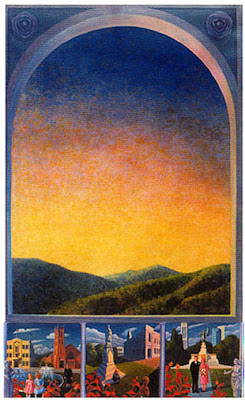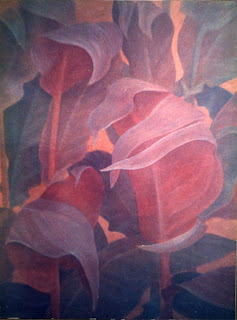3 – 22 November, Letham Gallery, Ponsonby, Auckland
In these works the scale is larger to enable the viewer to feel the presence of the hedge. Pioneer farmers needed to establish hedges for shelter from the relentless winds that sweep across our farmlands. Hedges also symbolise the spiritual shelter and comfort of the heritage they brought with them from distant homelands. The artist remembers her own farming ancestors in the names of the paintings.
 |
| Shelter for Selina 1998, Oil on board, 900x1200mm |
 |
| Shelter for Rosa Maria and Arron 1998, Oil on gesso on baord 900x1200mm private collection |
1997 The Other Side eof the Hedge 10 - 31 May
Artscape Gallery, Palmerston North

Works from 'The Other Side of the Hedge' series 1996-7,
500 x 350 mm Oil on board
No.4 Lemons and Freesias is still available

Some mixed media works from The Other Side of the Hedge series
450 x 300 mm, Black and white photographic elements with oil paint and drawing media
All works are in private collections
1997 The Other Side eof the Hedge 10 - 31 May Artscape Gallery, Palmerston North
 |
| Works from 'The Other Side of the Hedge' series 1996-7, 500 x 350 mm Oil on board No.4 Lemons and Freesias is still available |
 |
| Some mixed media works from The Other Side of the Hedge series 450 x 300 mm, Black and white photographic elements with oil paint and drawing media All works are in private collections |
Reviewed by Janet
Bayly
This is an
interesting exhibition by committed local artist Raemon Rolfe, which shows
considerable development since her last show here two years ago.
A macrocarpa tree
in the background and an empty bird’s nest in the foreground act as symbolic motifs in many of
this series of
paintings. The macrocarpas have
visually
arresting qualities
of light, texture and density.
Rolfe has collaged photographs of trees on to the painted surface, then
added more painting, drawing and layers of glaze, so the collages are seamless
but create curious perceptual shifts in the works.
Sculpted and
real-life photographed figures emerge hauntingly from trees in Nos 9 and
16. These macrocarpa hedge
paintings are lower-keyed in colour and more natural, subtle and ‘local’ than
Rolfe’s earlier work. The latest
paintings in this series are without the classic European still-life device of
the arched window frame, and feel freer because of that.
Rolfe uses the flower, the nest, still-life motifs, images of women and text, to express her concerns as a woman painter. They are still tableau, to be read like a symbolic dreamscape. The images are imbedded in an increasingly sophisticated technical and visual language. They also reflect some specific visual qualities of the Manawatu landscape, while placed within the European art historical context that Rolfe draws from. Her exhibition makes for consistently rewarding viewing.
1995 Golden Rules for Gardeners March 1995 Artscape Gallery, Palmerston North This series of ten paintings extends the garden metaphor to refer to the development of creative ideas. We use the same processes in the cultivation of plants as we use in the cultivation of our ideas; we select, subdivide, transplant, weed out, graft on, prune back, protect and nourish them.Gardening and thinking through ideas requires hard work, they both go through cycles of birth – death-rebirth and both will hopefully bare fruit.
 |
| Works from Golden Rules for Gardeners series Oil of gesso on board, 500 x 350 mm All works in private collections |
 |
| Going into the Garden Oil on gesso on board |
Review by Janet Bayly of Golden Rules for Gardeners, Evening Standard March 21, 1995
‘Garden loving Palmerstonians and lovers of art history will find a wealth of riches in Raemon Rolfe’s current exhibition. Raemon has built an impressive repertoire of skills based on 15th Century Italian and Flemish oil painting and glazing techniques The effect is an alluring combination of light, depth, detail and rich colour.
The Elements 1994-95 series combines views in the Esplanade gardens and visions altogether more mystical and ineffable. They are pure paeans to colour and light in their glowing banks of cloud. The strongest, most straightforward, yet spiritual works in this exhibition, thy seem to celebrate the miracle of vision and the joy of translating it through painting.
The Golden Rules for Gardeners series combines gardening metaphors, ancient symbols and renaissance painting models. Controlling the Pests and Diseases 1994-5 has two magical figures that over-ride their literal references to characters from London’s Great Plague. One dark man bears a fire on his head and another, wearing a beaked hood, looks like an Italian masquerade ball.
An effectively reworked historical family photograph in Dividing the Roots and Transplanting 1994-5 contrasts with the more crudely painted figures or the other paintings.
The gardener’s “golden rules” appear at the bottom of the paintings in shadowy script under a golden overlay. They read like an almost occult set of instructions for only the most dedicated student.
Surrealist women painters of the 1930s and 40s come to mind with Returning from the Garden 1993. Here, a girlish figure, starkly coloured, looks radiant with an energy more sexual than spiritual. This curious, startling image has a vibrant lucidity and other-worldliness.’
Reviewed by John Thornley March 1995
‘Manawatu painter Raemon Rolfe unites two roles, teacher and gardener, in her exhibition.
As a student of the early Renaissance Flemish and Italian artists, who employ layers of transparent glazes and opaque brush strokes or scumbling, she painstakingly built in oil paints rich and vibrant canvases. One work involves six weeks of paintiin
The pictures fall into three groups, with the six Golden Rules for Gardeners series as the centerpiece.
These smaller works combine textual cuttings and diagrams from Yates and Brett’s garden guides; courtly and garden imagery from Raphael, Fra Angelico and the Tres Riches Heures du duc de Berry; scenes from the artist’s own garden, the nearby Esplanade park and more distant nikau palms.
The subject titles remind us of the analogy between gardening and living purposefully: Budding and Grafting - Upright Leaders mean Strength; Dividing the Roots and Transplanting. The latter work explores her personal and cultural heritage, with a rose, kowhai seeds, grafted within the overall design.
The other two sequences include an earlier grouping of four works, which form a radiant triptych. Raising the cannas, one of the highlight of the show, depicts two angels blowing trumpets over a choir of canna lilies in incandescent hues of orange, red and yellow. All this is held together by a unifying golden wash base, the columned arch as foreground and recognisably New Zealand hills, clouds and sky as back drop.
The sky and clouds hover over and dominate the plains and low ranges of the third grouping of works, titled The Elements. This recent series presents a lighter and more spacious scenery.
The gardens of Raemon Rolfe are sophisticated creations, nurtured on our European cultural roots, and lovingly transplanted into a New Zealand setting.’





.jpg)














.jpg)
